How to Get Your Baby to Sleep Without a Swaddle
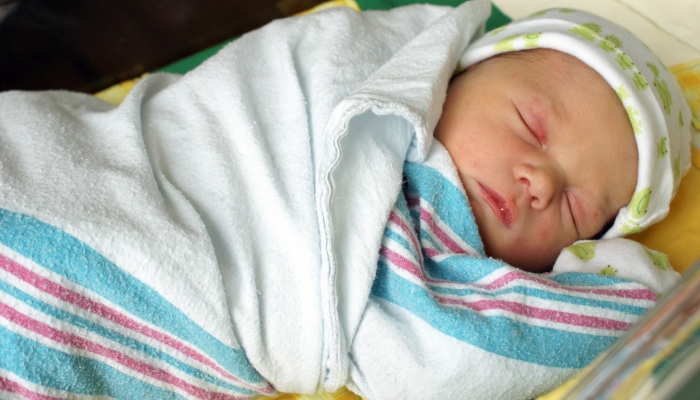
This post may contain affiliate links; please see our terms of use for details.
- Swaddling is helpful for a newborn but becomes risky for your older, more mobile baby.
- The best age to stop swaddling your baby is around 2 months. This allows time to transition slowly before they can roll over.
- You can gradually remove the swaddle blanket. Popular methods include swaddling with arms out, legs out, or using part-time swaddling.
- Most babies will accept sleep without a swaddle within a couple of weeks.
- Products such as sleep sacks can help ease the swaddle transition.
Ah, the swaddle. A cozy cocoon that mimics the comfort of the womb and helps your baby to sleep soundly.
I know how you feel. Wrapping my newborn up like a burrito and watching him fall asleep peacefully, I dreaded the day I needed to take the swaddle away.
It can be daunting to know how to get your baby to sleep without a swaddle. Changes to bedtime routines can be scary for parents who are clinging to every second of precious sleep.
The bad news? Your baby may take some time to adjust to a different way of sleeping if they’re used to being swaddled. The startle (Moro) reflex may also wake them up when not tucked in. Be prepared for some disrupted sleep periods and night waking to begin with.
The good news? With a little time and patience, your baby will get used to sleeping without their swaddle blanket. If you start preparing early, you can ease your baby into the change with minimal disruption.
Before you know it, you’ll be watching your baby sleep without a burrito wrap in sight!
When to Stop Swaddling Your Baby
Although all babies develop at different times, there are some clear signals that it’s time to transition out of the swaddle.
They’re Showing Signs of Rolling.
This is the number one sign that your baby is ready to lose the swaddle blanket.
For safety reasons, your young baby should not be sleeping face down. As soon as your baby is showing signs of trying to roll, the swaddle needs to go. This is because of the risk of your baby rolling onto their tummy and not being able to roll back over.
If your baby is already able to roll, you must stop swaddling immediately, which forces you to stop using it cold turkey. Some babies take to this sudden change well, but many find it difficult, so it’s best to start earlier if you can.
They’re Rejecting the Swaddle.
As your baby gets older, you may start to notice them resisting their swaddle. This is a good time to make the switch.
They may cry or squirm whilst being swaddled, wake up crying, or regularly wriggle out of their blanket.
Prepare to ditch the swaddle if you notice your wriggly baby consistently breaking free. Aside from being a sign that your baby isn’t content, loose blankets in their sleep space are against safe sleep guidance.
They’re 2 Months Old.
Typically, your baby becomes more mobile around 2 to 4 months. Many babies start to roll at around 3 months old. In terms of safety and easing your baby into the change, it’s advisable to get your baby used to slumbering without the swaddle nice and early.
2 months is a good time to start the process if they haven’t shown signs of rolling already. There’s no need to change the swaddle earlier than this unless you want to. It is a smart tool for newborns, and receiving blankets are typically used right from birth.
Their Startle Reflex Stops.
The startle (or ‘Moro’) reflex often wakes babies up. Your baby will suddenly jerk their arms open, perhaps in response to loud noise. Swaddling is an effective strategy for sleep as it reduces the disturbance caused by this reflex.
As they get older they will lose this natural reflex and may not need their swaddle anymore.
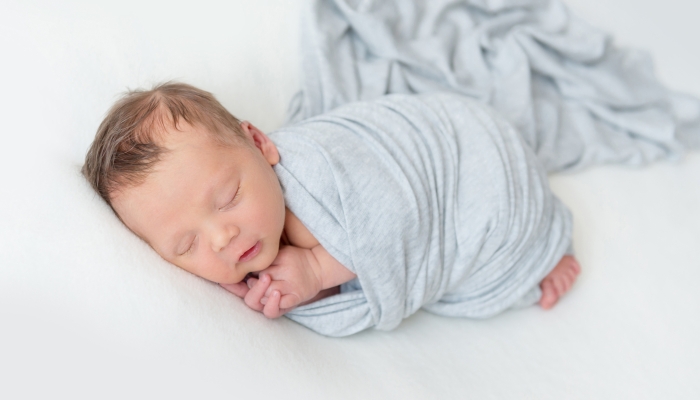
How to Get Your Baby to Sleep Without a Swaddle
Gazing at your peacefully sleeping swaddled baby, you might be terrified of taking the blanket away. You may worry that the change will risk losing all of your hard-earned sleep progress.
Remember that the swaddle is only one tool in your sleep routine toolbox. Techniques such as rocking, using white noise, and having a calm evening routine can help your baby to associate sleep with methods outside of the swaddle.
By keeping other sleep associations consistent, your baby’s more likely to adapt well to swaddle-free sleeping. As always, watch carefully for early signs that you have an overtired baby. It’s much harder for babies to settle to sleep once they feel too tired.
Remember that you don’t need to wave goodbye to the swaddle overnight (unless your baby starts rolling). A staged approach lets you notice how your baby responds to each stage of un-swaddling and gives them a chance to get used to unwrapped sleep. You may find a gentle approach is very effective in reducing sleep disruptions.
APP Guidance notes the safety issue of a swaddled baby rolling over. When your baby can roll, a gradual approach stops being an option.
Methods to Help Transition Out of a Swaddle
Although it can be tempting to wait until your baby is fully able to roll before you bid farewell to your faithful swaddle, a more gradual approach will probably make the change easier.
You can try to take the swaddle away completely first to see how your baby reacts. They might surprise you! If this doesn’t work for them, you can try one of the following techniques.
‘Arms Out’ Method
A popular method is to begin with one arm out of the swaddle, followed by an arms-free swaddle once ready.
For babies who love the security of a swaddle, this technique gives them a similar sensation whilst helping them to get used to some freedom of movement.
‘Legs Out’ Method
You could also try strapping just your baby’s arms and keeping their legs free. This can work particularly well if your baby is being woken up by their flailing arms.
If you have an enthusiastic nighttime kicker, they may like this approach. Just make sure they have plenty of room at the end of their crib!
Part-Time Swaddling
Another way to transition slowly is to only swaddle some of the time. You could try swaddle-free naps first. This has the added benefits of not disrupting your sleep and being able to watch how they react. Or, try swaddling for a section of the night, for example after a nighttime diaper change.
Every baby is different. A ‘trial and error’ approach will help you find what works best for you and your family. Sleep consultants can help you to navigate the process if you’re feeling nervous or your baby is struggling to adjust to the change.
Products to Help Transition Out of a Swaddle
Some babies will transition from a swaddle to a regular blanket with ease, whilst others will struggle. Luckily there are lots of transitional products which can help make the switch easier.
Love to Dream Transition Bag
- AN EASIER TRANSITION FROM SWADDLING TO ARMS FREE SLEEP: Once your baby starts to show signs of rolling, it’s time to stop swaddling and transition them to arms free sleep. Our unique, award winning Swaddle Up Transition Bag, is an easy way manage this change while helping to maintain an established sleep routine. Specially designed to provide the secure feeling of a swaddle while the zip-off wings allow a gentler and gradual move to arms-free sleeping.
- DESIGNED TO PRESERVE SLEEP ROUTINE & KEEPS BABY SETTLED: Our uniquely designed zip off wings allow for one arm to be free & the other swaddled, maintaining that familiar swaddled feeling. After a few nights, simply remove the remaining wing so both arms are free. This is an easy way to achieving arms free sleep while helping to preserve an established sleep routine. Once both wings are removed, continue to use as a sleeping bag providing the snug feeling baby is used to for longer-lasting use.
- SAFER SLEEP: Carefully designed with safety as a top priority. Swaddle Up stays on throughout sleep time, keeping your baby comfortable & feel secure with stretchy fabric that has a snug fit, without the need for blankets or loose layers making it a safer option. All our sleepwear are specially designed for different room temps & seasons to reduce the risk of overheating. Our products are made to the highest quality standards, are performance tested & certified by the relevant safety standards.
- SWADDLE IN SECONDS: Swaddle perfectly in seconds! Swaddle UP has one two-way zipper, no scratchy velcro, no fussy studs, just a super easy, convenient and simple to use swaddle that’s perfect for any parent, grandparent or caregiver, even in the middle of the night. Swaddle UP is designed for simplicity with no learning curve and no breakouts. The clever twin zipper means quick and easy diaper changes.
This popular baby sleep sack helps babies adjust gradually by keeping their arms swaddled in a natural ‘arms up’ position. Once they’re ready to move on, you can zip the wings off, turning it into a regular sleep sack.
Anna & Eve Swaddle Strap
- Comfortable, Safe & Secure – Made with 100% premium cotton and baby-friendly hook-and-loop closures (smooth but strong), Swaddle Strap baby swaddle provides a gentle, cozy wrap to help your infant sleep soundly. Swaddle baby in comfort and security with our adjustable swaddle strap, designed with an inner strap that prevents it from sliding up over baby’s face and soft pillows for a comfy fit. Our swaddle encloses the arms and leaves hips and legs free, so its HIP-HEALTHY!
- Easy-to-Use & Perfect for Any Weather – Swaddling baby is quick and effortless with our design. Goes on in 4 easy steps and stays on. Swaddle baby securely with the least fabric of any swaddle – no blanket needed – so baby stays cool in warm weather! In cool weather, use with your choice of blanket or sleep sack for perfect temperature control. Even change diapers without undoing swaddle!
- Perfect Fit for Growing Infants – 2 Sizes are carefully designed with adjustable hook-and-loop closures to give Swaddle Strap baby swaddle a range of fit that grows with your baby. PLEASE READ CAREFULLY TO SELECT THE RIGHT SIZE! Measure around baby’s chest with soft tape measure and use chest size (not age/weight) to select the perfect size: SMALL SIZE fits chest size from 13.5” to17” (34cm-43cm / newborns to approx. 3 months). LARGE SIZE fits chest size from 16″ to 20.5″ (41-52 cm: approx. 2-6 months). See photos for how to measure.
- High Quality Materials & Careful Craftmanship – Designed and perfected with our own baby for safety and comfort. We use 100% premium cotton that is soft & NON-stretching with hospital grade hook-and-loop closures. Because the fabric does not stretch, and the hook-and-loop covers a wide area, you can easily achieve a comfortable, secure swaddle with the least amount of fabric in only 4 easy steps!
A swaddle strap can be particularly helpful for babies who roll early but still have a strong startle reflex. This strap keeps the baby’s legs free whilst swaddling their arms. This is also a great option for swaddling in warmer weather.
Baby Merlin’s Magic Sleepsuit
- Swaddle Transition Product: Baby Merlin’s Magic Sleepsuit is designed for babies aged three to six months; helps transition from swaddling while promoting healthy sleep habits critical for development
- Soft Design: The merlin sleep suit is made with a soft jersey cotton outer and inner layer, with a polyfil layer in between for breathable comfort; also available in cozy microfleece for extra warmth
- Easy Diaper Changes: The merlins magic sleepsuit features a double zipper design for quick and easy diaper changes; machine washable for easy care, making life simpler for parents with little ones
- Comfortable Sleep: The Magic Merlin Sleepsuit 3-6 months encourages back sleeping in cribs; proper fit ensure comfort, giving parents peace of mind as their baby transitions from swaddling
Specifically designed to ease the transition from a swaddle, this product keeps your baby warm and snug. The clever double zip system keeps nighttime diaper changes stress-free.
Burt’s Bees Wearable Blanket
- Made from Premium-Quality Organic Cotton: Burt’s Bees Baby Beekeepers are made of natural materials ensuring they are gentle on little bees’ delicate skin.
- Designed for Safety: Our wearable blanket always considers the safety of your little bee. It is thoughtfully designed with an interior zipper guard and zipper pull cover so babies can move around freely. It is an excellent gift for boys and girls.
- Easy to Use and Wash: This baby beekeeper’s zipper closure makes it easy to use. The zipper opens from the bottom for easy late-night diaper changes. These beekeepers are also easy to care for. Cold machine wash under a gentle cycle. Then tumble dry low.
- Available in Multiple Sizes: The 100 percent organic wearable blanket is available in various thoughtfully designed sizes for babies from 0 to 6 months (10 lbs) and 18 to 24 months (up to 36 lbs). Please refer to the size chart before ordering.
A wearable blanket or baby sleep sack will keep your baby cozy whilst avoiding the risk of loose blankets.
If using a product to help with the transition, remember to pick something which adheres to safe sleep guidance. It’s worth persevering with a new product for at least a week, as it may take a little time for your baby to get used to it.
How Long Will It Take for My Baby to Sleep Without Swaddling?
Changing things which have worked well for you and your baby can be scary. Unfortunately, swaddling is only temporary, but you’ll be pleased to hear that most babies accept sleep without a swaddle within a few weeks.
Remember that all babies are different and follow their own unique paths, so don’t be disheartened if your baby takes a little longer to adjust.
As long as your baby is not rolling over, you can take a slow and steady approach. Allow your baby to get used to a partial swaddle before moving on.
Allow up to a month of trying the gradual approach, only moving forwards once your baby has fully accepted each stage. If your baby is fighting sleep, you may have to play detective to work out the cause.
You could consider trying a gentle sleep training process to help them settle:
| Age that Method is Suitable From | Method |
| 3 months | ‘Pick up and Put Down’ |
| 4 months | Chair Method |
| 6 months | Fading Sleep Training |
Sleep consultants can help you discover further solutions. It may be that you have an overstimulated baby or that they’re under or over tired.
It will take time and patience, but fear not, both you and your baby will soon adjust to swaddle-free sleep.
FAQS
Should I stop swaddling when my baby starts rolling over?
Yes. Swaddling becomes dangerous when they can roll over so it’s best to begin the transition as soon as your baby starts showing signs of rolling. You must stop swaddling cold turkey if your baby starts being able to roll.
How do I stop swaddling during daytime naps?
It can be helpful to practice sleeping unswaddled during nap time first so that you can watch for your baby’s response. You can use the same process as you would for nighttime sleep and use a wearable blanket or sleeping bag if you wish.
You may also find it’s easier to try sleep training for naps before tackling the nighttime.
Will my baby stop sleeping if I stop swaddling?
As with any change to your baby’s normal routine, it can take a little while for both of you to get used to a new way of doing things. You may find it takes longer for your baby to fall asleep without their trusty swaddle blanket.
Expect some sleep disruption for at least a few nights. If it takes much longer than this and you’re finding that your baby won’t sleep, you may need to make some further adjustments to your sleep routine.
How can I use old swaddle blankets?
You could consider using old swaddles as a lovey or comforter (only use outside of the crib until they’re 12 months old). They can also double up as burp cloths or a surface for tummy time, so there’s no need to throw your unused blankets away!
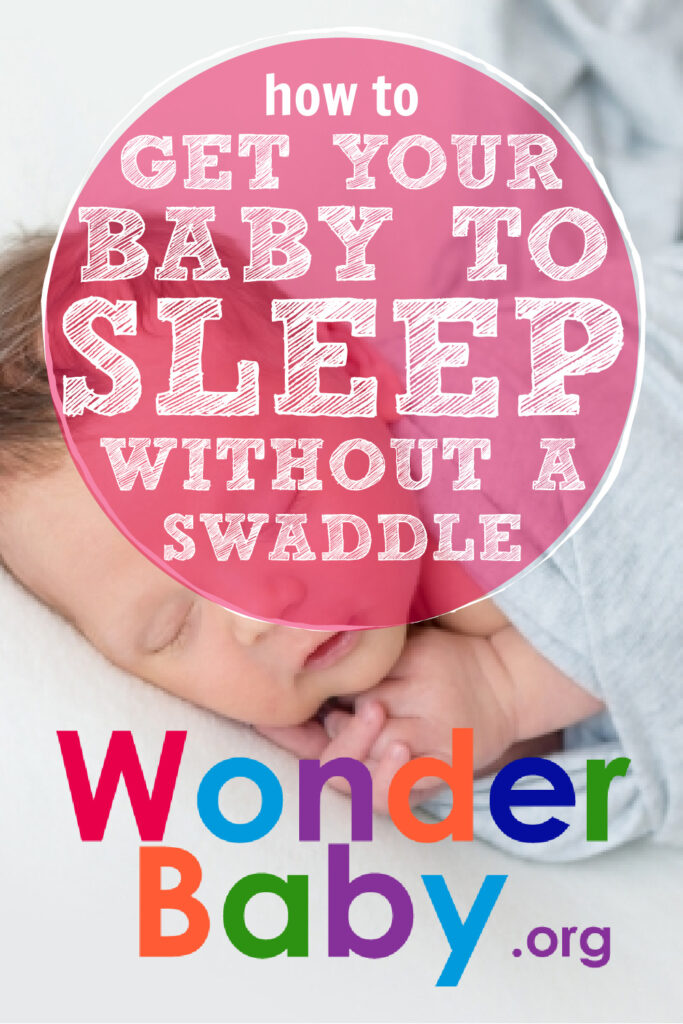
Related Posts
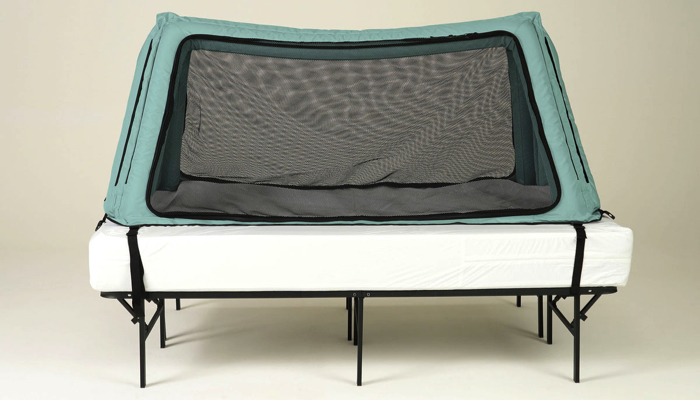
Sleep, Special Needs
Safe Place Bedding Travel Bed Review
Traveling with a special needs child can be stressful! Having a safe, durable, and easy to use travel bed can make traveling so much easier!
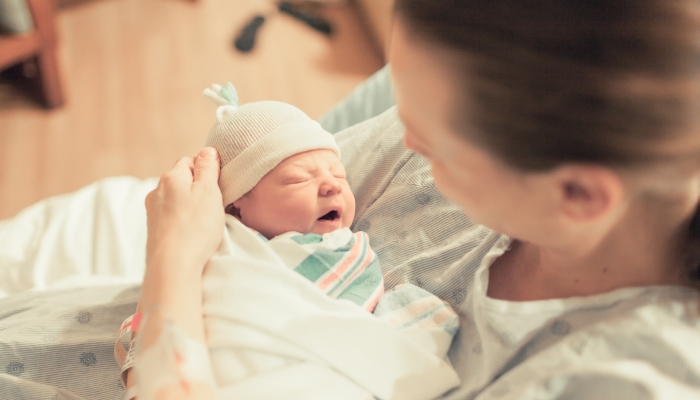
Sleep, Special Needs
Sleep Regimen for Premature Babies: Special Considerations
It can take premature babies much longer than their full-term peers to sleep for long stretches. A preemie sleep schedule may encourage better sleep.
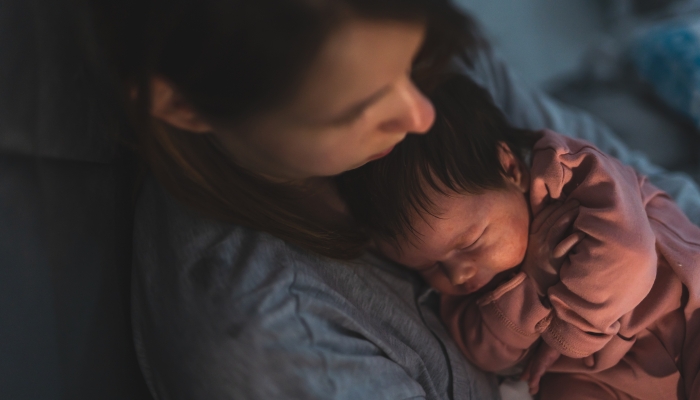
Sleep
Mastering the Bedtime Routine: 3 Tips for a Peaceful Night’s Sleep
From around six weeks, a newborn bedtime routine can help your baby learn the difference between day and night and prepare for a restful night’s sleep.



